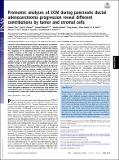| dc.contributor.author | Tian, Chenxi | |
| dc.contributor.author | Clauser, Karl R. | |
| dc.contributor.author | Öhlund, Daniel | |
| dc.contributor.author | Rickelt, Steffen | |
| dc.contributor.author | Huang, Ying | |
| dc.contributor.author | Gupta, Mala | |
| dc.contributor.author | Mani, D. R. | |
| dc.contributor.author | Carr, Steven A. | |
| dc.contributor.author | Tuveson, David A. | |
| dc.contributor.author | Hynes, Richard O | |
| dc.date.accessioned | 2020-07-02T13:48:20Z | |
| dc.date.available | 2020-07-02T13:48:20Z | |
| dc.date.issued | 2019-09 | |
| dc.date.submitted | 2019-05 | |
| dc.identifier.issn | 0027-8424 | |
| dc.identifier.issn | 1091-6490 | |
| dc.identifier.uri | https://hdl.handle.net/1721.1/126050 | |
| dc.description.abstract | Pancreatic ductal adenocarcinoma (PDAC) has prominent extracellular matrix (ECM) that compromises treatments yet cannot be nonselectively disrupted without adverse consequences. ECM of PDAC, despite the recognition of its importance, has not been comprehensively studied in patients. In this study, we used quantitative mass spectrometry (MS)-based proteomics to characterize ECM proteins in normal pancreas and pancreatic intraepithelial neoplasia (PanIN)- and PDAC-bearing pancreas from both human patients and mouse genetic models, as well as chronic pancreatitis patient samples. We describe detailed changes in both abundance and complexity of matrisome proteins in the course of PDAC progression. We reveal an early upregulated group of matrisome proteins in PanIN, which are further upregulated in PDAC, and we uncover notable similarities in matrix changes between pancreatitis and PDAC. We further assigned cellular origins to matrisome proteins by performing MS on multiple lines of human-to-mouse xenograft tumors. We found that, although stromal cells produce over 90% of the ECM mass, elevated levels of ECM proteins derived from the tumor cells, but not those produced exclusively by stromal cells, tend to correlate with poor patient survival. Furthermore, distinct pathwayswere implicated in regulating expression of matrisome proteins in cancer cells and stromal cells. We suggest that, rather than global suppression of ECM production, more precise ECM manipulations, such as targeting tumor-promoting ECM proteins and their regulators in cancer cells, could be more effective therapeutically. | en_US |
| dc.language.iso | en | |
| dc.publisher | Proceedings of the National Academy of Sciences | en_US |
| dc.relation.isversionof | http://dx.doi.org/10.1073/pnas.1908626116 | en_US |
| dc.rights | Article is made available in accordance with the publisher's policy and may be subject to US copyright law. Please refer to the publisher's site for terms of use. | en_US |
| dc.source | PNAS | en_US |
| dc.title | Proteomic analyses of ECM during pancreatic ductal adenocarcinoma progression reveal different contributions by tumor and stromal cells | en_US |
| dc.type | Article | en_US |
| dc.identifier.citation | Tian, Chenxi et al. "Proteomic analyses of ECM during pancreatic ductal adenocarcinoma progression reveal different contributions by tumor and stromal cells." Proceedings of the National Academy of Sciences 115, 39 (September 2019): 19609-19618 © 2019 National Academy of Sciences | en_US |
| dc.contributor.department | Koch Institute for Integrative Cancer Research at MIT | en_US |
| dc.relation.journal | Proceedings of the National Academy of Sciences | en_US |
| dc.eprint.version | Final published version | en_US |
| dc.type.uri | http://purl.org/eprint/type/JournalArticle | en_US |
| eprint.status | http://purl.org/eprint/status/PeerReviewed | en_US |
| dc.date.updated | 2019-12-09T18:26:18Z | |
| dspace.date.submission | 2019-12-09T18:26:22Z | |
| mit.journal.volume | 116 | en_US |
| mit.journal.issue | 39 | en_US |
| mit.metadata.status | Complete | |
